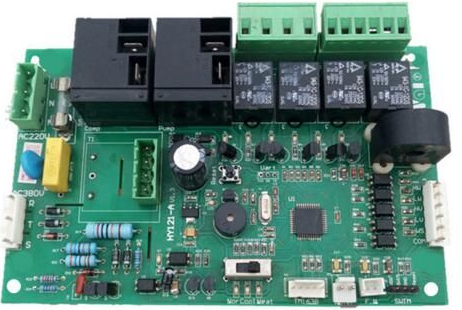The main equipment of the smt processing production line includes solder paste printers, flatbed machines, reflow ovens, and AOI automatic optical testers. When preparing to start the SMT patch 4 production line, you must understand the SMT patch production process and choose to maximize and not waste the production capacity of the smt processing production line.
1. Template: PCB designed by smt processing determines whether the template is processed. If the PCB has resistors, capacitors, and repair components with more than 1206 packages, you can apply solder paste with a syringe or automatic adhesive equipment without creating a template. If the PCB contains SOT, SOP, PQFP, PLCC and BGA packaged chips, resistors and capacitor packages below 0805, you need to create a template. The universal template is a chemically etched copper template (low price, small batch size, 0.635mm between test and chip pins; greater than). Laser etched stainless steel template (large batch,

high precision and high price when the distance between automatic production line and chip pin is less than 0.5mm). It is recommended to use etched stainless steel templates in R&D, small-scale production, or gaps above 0.5mm. Use laser-cut stainless steel templates in mass production or gaps less than 0.5mm. The appearance specification is 370 * 470 (in millimeters), and the effective area is 300.
2. Screen printing: (Zhichi high-precision semi-automatic solder paste printer) engrave the wiper or patch glue on the soldering board of the PCB to prepare the attached parts. This is its function. The equipment used includes manual tabs (screen printer), templates and scrapers (metal or rubber), located in front of the SMT production line. Our company recommends using a mid-end, precision semi-automatic screen printing method to fix the template on the screen. Use the up, down, left, and right knobs of the manual tab to confirm the position of the PCB on the screen platform, and fix this position. Then, put the required coated PCB between the screen platform and the template, put the solder paste on the screen board at room temperature, keep the template and PCB parallel, and use a scraper to evenly spread the solder paste on the PCB. In the process of smt processing and use, clean the mold with alcohol in time to prevent the mold from being blocked by the casting oil.
3. Configuration: (JUKI configuration machine, Panasonic configuration machine, Siemens configuration machine) can accurately position the curved configuration parts on the fixed position of the PCB. The equipment used includes batch machines (automatic, semi-automatic or manual), vacuum suction pens or tweezers (located behind the tabs on the SMT production line). Our company generally recommends using a dual-pen anti-static vacuum suction pen for laboratories or small batches. In order to solve the deployment and deployment problems of high-precision chips (the chip pin spacing is less than 0.5mm),
Because the solder paste can be placed directly where resistors and capacitors are needed, the vacuum chuck can directly select resistors, capacitors and chips from the component rack. For chips, a suction cup can be added to the vacuum suction cup, and the suction size can be adjusted by the knob. If the position is not placed correctly (it has nothing to do with the placed components), you need to clean the PCB with alcohol, reprint the PCB, and then reposition the components. 4. Reflow soldering: (HELLER reflow soldering, wave force reflow soldering) melting solder paste, soldering surface mount components with PCB, realizing the electrical characteristics required by the design, precise control according to the international standard curve, and effectively preventing the heat of PCB and components Damage and deformation. The equipment used is the reflow oven (automatic infrared/hot air reflow oven) behind the batch machine on the SMT production line.
5. Cleaning: It has the function of removing substances that affect electrical performance or brazing residues (such as brazing) on the bonded PCB. The use of brazing that does not require cleaning, generally does not require cleaning. Micro-power products or high-frequency products need to be cleaned, and general products are free of cleaning. If the equipment used is directly hand-washed with an ultrasonic cleaner or alcohol, the position cannot be fixed.
6. Inspection: It is used to verify the welding quality and assembly quality of the attached PCB. The equipment used can have a magnifying glass, microscope, position according to inspection requirements, and the production line is configured in a suitable place.
7. Rework: play a role in detecting the rework of faulty PCBs, such as solder balls, solder bridges, openings and other defects. The tools used are smart soldering irons, rework stations, etc. Assign to any position in the production line.